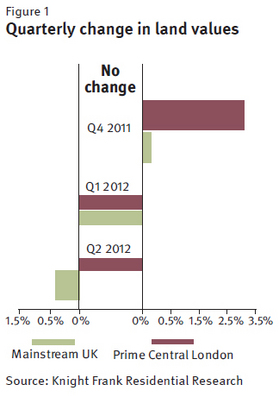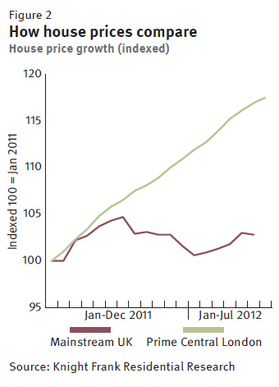The WPJ
THE WORLD PROPERTY JOURNALReal Estate Facts Not Fiction
Residential Real Estate News

UK Residential Land Price Index Dips in Q2, Despite Being Land Constrained
Residential News » Europe Residential News Edition | By Michael Gerrity | August 3, 2012 9:30 AM ET
Based on global real estate consulting firm Knight Frank's latest UK Residential Land Development Index for Q2, 2012, London's development land held on to last year's 20.3% price increases, while prices in the rest of the UK have fallen by 0.4% in the last Quarter.
Knight Frank's Gráinne Gilmore tells World Property Channel that their development land index signals that prices slipped slightly outside London in Q2, partly reversing the 1.3% rise seen last year. London prices remained unchanged for the second quarter in a row.
UK Residential Land Index Results for Q2
- The average value of residential land slid by 0.4% in England and Wales between April and June 2012.
- Prime central London development land prices remained unchanged for the second consecutive quarter.
- Supply of residential development land is still constrained
The UK
The price of development land across the UK fell marginally between April and June, after no change in the first quarter of the year. This comes after a 1.3% rise in values last year. Land prices are broadly mirroring the movement of mainstream house prices in the UK, which have fallen by around 0.3% since the start of the year.
 Given the lack of house price growth across the UK, there is little reason to expect further increases in land values in the short term.
Given the lack of house price growth across the UK, there is little reason to expect further increases in land values in the short term.On the other hand, the finite supply of development land, caused partly by the backlogs and uncertainty in the planning system, is to some extent putting a floor under land prices.
But there are concerns that the new Community Infrastructure Levy (CIL) which is currently being looked at across the UK could change this balance.
Any additional cost levied on house builders or developers is likely to have a negative effect on development land values as this is where such a cost would be recouped.
The CIL is being viewed as just such a cost. There is also disquiet that the levy has yet to be finally decided in many areas, creating uncertainty over what the charge might be.
The outlook is for no sharp price movements for UK development land in the near future, unless the extra cost of CIL tips the balance, or house prices take a sharp downward turn.
Prime Central London
Development land values remained unchanged again in the second quarter, after jumping by 20.3% last year.
 The trend in the market in the second quarter also remained much the same as in the first three months of the year, with good levels of demand for stock where developers and investors see opportunities for a realistic and deliverable margin.
The trend in the market in the second quarter also remained much the same as in the first three months of the year, with good levels of demand for stock where developers and investors see opportunities for a realistic and deliverable margin.While the market has an appetite for development risk, it will not speculate on planning risk. As a consequence, the unconditional trading market now has a sensible risk-reward arbitrage. We see this position remaining for the long term.
The funding environment remains tough and as a consequence the market is becoming increasingly dominated by balance sheet buyers and high-net-worth investor developers. Pure equity investors are finding the market a difficult environment to place capital into as their IRR expectations are suppressing their bidding competitiveness.
Sign Up Free | The WPJ Weekly Newsletter
Relevant real estate news.
Actionable market intelligence.
Right to your inbox every week.
Real Estate Listings Showcase
Related News Stories
Residential Real Estate Headlines
- More Americans Opting for Renting Over Homeownership in 2024
- BLOCKTITLE Global Property Tokenization Platform Announced
- Small Investors Quietly Reshaping the U.S. Housing Market in Late 2024
- Greater Miami Overall Residential Sales Dip 9 Percent in November
- U.S. Home Sales Enjoy Largest Annual Increase in 3 Years Post Presidential Election
- U.S. Housing Industry Reacts to the Federal Reserve's Late 2024 Rate Cut
- U.S. Home Builders Express Optimism for 2025
- Older Americans More Likely to Buy Disaster-Prone Homes
- NAR's 10 Top U.S. Housing Markets for 2025 Revealed
- U.S. Mortgage Delinquencies Continue to Rise in September
- U.S. Mortgage Rates Tick Down in Early December
- Post Trump Election, U.S. Homebuyer Sentiment Hits 3-Year High in November
- Global Listings Aims to Become the Future 'Amazon of Real Estate' Shopping Platform
- Greater Las Vegas Home Sales Jump 15 Percent in November
- Ultra Luxury Home Sales Globally Experience Slowdown in Q3
- World Property Exchange Announces Development Plan
- Hong Kong Housing Market to Reach Equilibrium in Late 2025
- Construction Job Openings in U.S. Down 40 Percent Annually in October
- U.S. Mortgage Applications Increase in Late October
- World Property Markets, World Property Media to Commence Industry Joint-Venture Funding Rounds in 2025
- New Home Sales Hit 2 Year Low in America
- U.S. Pending Home Sales Increase for Third Consecutive Month in October
- Pandemic-led Residential Rent Boom is Now Fizzling in the U.S.
- Emerging Global Real Estate Streamer WPC TV Expands Video Programming Lineup
- 1 in 5 Renters in America Entire Paycheck Used to Pay Monthly Rent in 2024
- U.S. Home Sales Jump 3.4 Percent in October
- Home Buyers Negotiation Power Grows Amid Cooling U.S. Market
- Canadian Home Sales Surge in October, Reaching a Two-Year High
- Greater Orlando Area Home Sales Continue to Slide in October
- U.S. Mortgage Credit Availability Increased in October
- U.S. Mortgage Rates Remain Stubbornly High Post Election, Rate Cuts
- Construction Input Prices Continue to Rise in October
- BETTER MLS: A New Agent and Broker Owned National Listings Platform Announced
- Home Prices Rise in 87 Percent of U.S. Metros in Q3
- Caribbean Islands Enjoying a New Era of Luxury Property Developments
- The World's First 'Global Listings Service' Announced
- Agent Commission Rates Continue to Slip Post NAR Settlement
- Market Share of First Time Home Buyers Hit Historic Low in U.S.
- Greater Palm Beach Area Residential Sales Drop 20 Percent Annually in September
- Mortgage Applications in U.S. Dip in Late October
Reader Poll
Marketplace Links
This website uses cookies to improve user experience. By using our website you consent in accordance with our Cookie Policy. Read More





